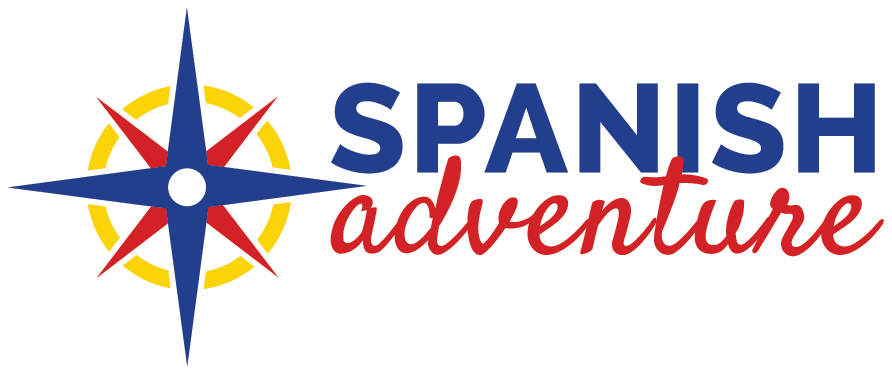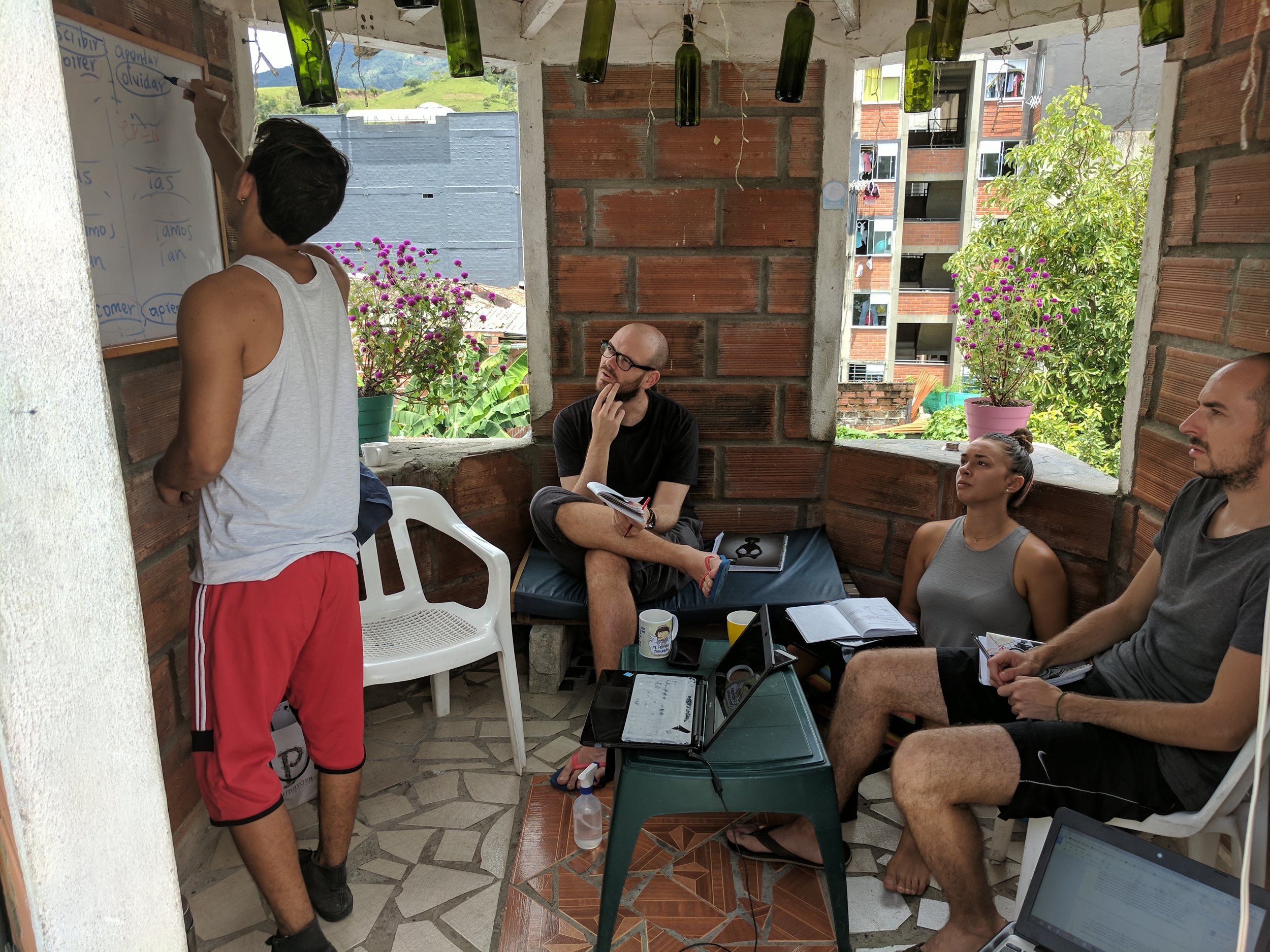A Day In The Life of a Spanish Adventure Student
Growing up in the States, we technically “learn” Spanish as a second language. After 4 years of high school Spanish, I was really good at saying “Sit down”, “Spit out your gum”, and “Be quiet”.
10 years later, I’m solo vagabonding through South America, and all I can think about is how I really shouldn’t have let my friend Martha do my Spanish homework while I focused on Calculus. I can integrate the hell out of an equation, but can I ask where the bus station is and then understand the answer? Probablamente no.
I studied Duolingo for 6 months before arriving in Colombia, which is great for building vocabulary but knowing how to say “La araña come pan” (the spider eats bread) isn’t the most useful phrase for vagabonding.
What I needed was a way to practically learn and apply Spanish. I wanted to be able to communicate with locals. I wanted to make a friend with someone who only speaks Spanish. I wanted to understand where the damn bus station is.
What did I find?
Spanish Adventure! A language immersion school that teaches you Spanish in the most fun, interactive, and natural way possible. Here’s a day in the life:
7:30am: Stumble over to industrial size coffee machine to power the troops for Spanish classes.
8-10am: Person 1 & 2 take private Spanish classes.
Person 1, Eric, (nbd, but here is a link to Eric when he was the #1 world food eating champ) learns about perfect and imperfect tenses, while conversing with the professor, Camillo, about things he has done in the past.
Person 2, Brooke, learns irregular verbs (and really, aren’t they all irregular), discusses how to make brownies (no, not special brownies), and goes on a fake date with her professor, Daniel.
8:15am: Bootcamp workout for those who don’t have Spanish class until 10am. Sweat, blood, and tears: that’s how we do it here at #SpanishAdventure.
Similar facial expression as when we're trying to learn imperfect v perfect tenses.
10am-Noon: Groups 3 & 4 take Spanish classes. Group 3 starts off presenting yesterday’s homework:
Describe what you did last year, the day before yesterday, last night, and this morning.
Name 5 places you’ve been, how long you stayed, and 3 things you did there.
Professor Daniel patiently corrects mistakes, while the students furiously scribble in their notebooks, soaking up the knowledge like sponges.
After presenting yesterday’s homework, the students learn imperfect and past tenses, focusing on irregular verbs. Anthony (British) gets mad at how irregular the irregular verbs are. Sam (Canadian) has a confused expression on her face until she takes her 10th sip of coffee; then, it alllll makes sense. Max (German) just nails it all. But somehow doesn’t know what frijoles are when it comes time to order lunch.
1pm: Break for lunch! Y almuerzo esta muyyyy rico. Meat of choice/eggplant for the vegetarians, rice, plantains, salad, and maracuya juice, all served in the restaurant downstairs. Great fuel for….
3pm: Afternoon adventure! Time to put Spanish lessons to practical use. No English is allowed, and we all speak to each other like we’re 5 year olds. 5 year olds who want to learn the word for “hangover” (“resaca”) and then mumble “resaca” “resaca” “resaca” all the way to the adventure destination. And today’s destination? Una cascada (a waterfall)!
Our fearless guide, Christian (aka owner of downstairs restaurant) leads the brave souls to swim behind the waterfall (#freemassage) and cliff jump.
5/6pm: Return from adventure, work on Spanish homework, nap, snack, relax.
9pm: Group dinner for those who are on the Latin dinner time. Friends of the professors join, and again, we have a real-life opportunity to practice our Spanish with the locals. We laugh and joke (aka spend 10 minutes explaining/translating a not-so-funny joke) as we feast on tacos and learn more about each others’ cultures, way of life, and of course, languages!
Mañana, we put our Spanish knowledge to use by completing a scavenger hunt where we need to ask the locals questions in order to uncover our next clue. Vamos a hacerlo!
-
A typical day includes Spanish classes in the morning, physical activities like bootcamp, a delicious local lunch, nature adventures, and constant language practice with locals. It's a fun, immersive, and effective way to learn Spanish.
-
Classes are immersive but enjoyable. They focus on grammar, vocabulary, and practical conversation. You’ll work on verb tenses, travel vocabulary, and ordering food. Teachers are patient and supportive throughout the process.
-
Nope! Many students arrive with little to no Spanish. Any previous knowledge (even just Duolingo) helps, but the immersive environment ensures you'll be speaking confidently in no time.
-
Yes — all the time! Whether you're ordering lunch, hiking to a waterfall, or having dinner with locals, you'll be using Spanish constantly. It's all about applying what you learn in real-life situations.
-
Hikes to waterfalls, cooking classes, scavenger hunts, local games, bootcamps, cultural dinners — every activity is a chance to practice Spanish while connecting with people and nature.
-
No — it's a full-on experience. You’ll learn Spanish, make global friendships, connect with locals, and enjoy life in a beautiful Colombian town. It’s language, travel, and personal growth all rolled into one.
-
The food is delicious, home-cooked Colombian cuisine with vegetarian options. Accommodation is cozy, clean, and right next to the classroom and restaurant — everything you need for a comfortable immersion.
-
In big cities like Medellín or Bogotá, it’s easy to stay in the tourist bubble and speak English. In San Carlos, you’re surrounded by nature and locals — real immersion, real connection, real progress.
-
It’s totally okay! Everyone’s learning. The community is friendly and encouraging. Mistakes are part of the journey — and here, they’re celebrated as progress.
-
Absolutely. Many students travel solo and end up forming lifelong friendships. It’s the perfect way to meet like-minded people while improving your Spanish and discovering Colombia.





